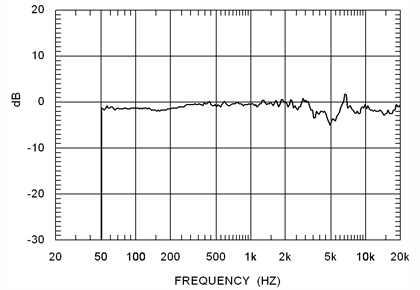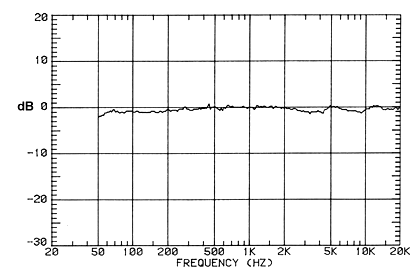One thing I like about SoundStage's online magazine is that they often test speakers at the NRC facility in Canada. One test they do I find interesting - they compare response curves at 2M for 70db and 90db levels. To see an example look at chart #4 here: http://www.soundstagenetwork.com/mea...3_strata_mini/
NRC tests
Collapse
This topic is closed.
X
X
-
Tags: None
- Bottom
-
That looks like a good reference measurement
I haven't seen that before, I like that idea. I may do some testing using that approach when I measure. It tends to show some of the non-linear distortion in something of a "lumped sum" approach when using an MLS signal. That kind of measurement set alone can't delineate linear from non-linear, but there is an interesting correlation between FR and distortion. What's most interesting in the linked examples is that it's not a measurement of the raw drivers. It's the final system response and consequent distortion with a crossover in place that is to me the most important.Originally posted by Rick CraigOne thing I like about SoundStage's online magazine is that they often test speakers at the NRC facility in Canada. One test they do I find interesting - they compare response curves at 2M for 70db and 90db levels. To see an example look at chart #4 here: http://www.soundstagenetwork.com/mea...3_strata_mini/
I looked for another speaker to compare and found the B&W CM1 llink on the front page. I couldn't find a test of a true hard-coned system with NRC measurements in a quick check. The little 5" Kevlar midwoofer with their aluminum dome tweeter, both considered by some to under-perform due to preconceived notions of energy storage issues due to material, are exceptional in dynamic linearity in comparison to the 3.5-way in your link, shown below. I've got links directly to the graphs if the IMG display doesn't work right.
The initial graph is shown below.
3.5-way 70-90db normalized response

In comparison, the little 2-way is shown next.
5" 2-way 70-90db normlized response

For more perspective, here's their measurement of an Usher 2-way, the V-602. This, however, is a floor-stander with a 7" midwoofer so, as with the first one, the deck would seem to be stacked against the little 5" woofer and indeed this one does do better, but primarily below about 250Hz, not unexpected comparing a 5" to a 7" driver.
Usher 7" woofer 2-way 70-90db normalized response

They supplied an extra normalized response with an additional 5db output, shown next.
User 2-way 70-95db normalized response

So even this larger system starts to show distortion creeping in at this signal level. Too bad the others don't show the 95db response.
Another comparison that would prove interesting would be one with, say, the Usher against some equivalently sized hard coned driver. The Usher is like one of my favorites woofers, the 25w/8565-01. Some would say that being doped paper and "floppy" (not hard coned) that it will exhibit excessive dynamic llinearity (compression) problems. The measurements shown indicate it to start only somewhere above 90db @2m, more than enough for my listening levels.- Bottom
-
You took this thread to another level ;x(Originally posted by dlrI haven't seen that before, I like that idea. I may do some testing using that approach when I measure. It tends to show some of the non-linear distortion in something of a "lumped sum" approach when using an MLS signal. That kind of measurement set alone can't delineate linear from non-linear, but there is an interesting correlation between FR and distortion. What's most interesting in the linked examples is that it's not a measurement of the raw drivers. It's the final system response and consequent distortion with a crossover in place that is to me the most important.
I looked for another speaker to compare and found the B&W CM1 llink on the front page. I couldn't find a test of a true hard-coned system with NRC measurements in a quick check. The little 5" Kevlar midwoofer with their aluminum dome tweeter, both considered by some to under-perform due to preconceived notions of energy storage issues due to material, are exceptional in dynamic linearity in comparison to the 3.5-way in your link, shown below. I've got links directly to the graphs if the IMG display doesn't work right.
The initial graph is shown below.
3.5-way 70-90db normalized response

In comparison, the little 2-way is shown next.
5" 2-way 70-90db normlized response

For more perspective, here's their measurement of an Usher 2-way, the V-602. This, however, is a floor-stander with a 7" midwoofer so, as with the first one, the deck would seem to be stacked against the little 5" woofer and indeed this one does do better, but primarily below about 250Hz, not unexpected comparing a 5" to a 7" driver.
Usher 7" woofer 2-way 70-90db normalized response

They supplied an extra normalized response with an additional 5db output, shown next.
User 2-way 70-95db normalized response

So even this larger system starts to show distortion creeping in at this signal level. Too bad the others don't show the 95db response.
Another comparison that would prove interesting would be one with, say, the Usher against some equivalently sized hard coned driver. The Usher is like one of my favorites woofers, the 25w/8565-01. Some would say that being doped paper and "floppy" (not hard coned) that it will exhibit excessive dynamic llinearity (compression) problems. The measurements shown indicate it to start only somewhere above 90db @2m, more than enough for my listening levels.
Seriously, this is the kind of test that really shows something that will be audible and is simple to do. With respect to the speakers here I suspect some of the problem could be due to the crossover components. With a commercial budget speaker a small iron core inductor can saturate at higher drive levels which could explain some of what we see with the AV123 and B&W. It also may be thermal compression of the woofer (AV123 and B&W).
What's more alarming are the problems are the problems with the AV123 that start at 3K and go all the way out to 20K! I know resistors can be affected by operating temperature but I would guess this is a driver linearity problem (unless for some reason they cheaped out and used a small iron core there in the circuit). It's also possible that the crossover isn't providing enough protection for the driver - too low of a crossover point and / or a slope that's too shallow.- Bottom
Comment
-
I think you're on the right track, Rick- might be enough VC heating to change RDC significantly. Death to inexpensive cored inductors. One of the worst examples I've heard of that in an "expensive" speaker was at the Legacy Audio factory, and what I believe to be ferrite bobbin core inductors in the crossover were saturating at high drive levels and causing a cracking kind of sound that I think was the amplifier protection circuits kicking in.
Well, this is weird- I was in Raleigh last week, in Singapore this week, and it's actually cooler in Singapore than Raleigh- believe me, this doesn't happen often.the AudioWorx
Natalie P
M8ta
Modula Neo DCC
Modula MT XE
Modula Xtreme
Isiris
Wavecor Ardent
SMJ
Minerva Monitor
Calliope
Ardent D
In Development...
Isiris Mk II updates- in final test stage!
Obi-Wan
Saint-Saëns Symphonique/AKA SMJ-40
Modula PWB
Calliope CC Supreme
Natalie P Ultra
Natalie P Supreme
Janus BP1 Sub
Resistance is not futile, it is Volts divided by Amperes...
Just ask Mr. Ohm....- Bottom
Comment
-
Could it be that the planar mid and tweeter in the AV123 mini strata are cheap crap? I see no mention of it being the likes of the BGneo8. Perhaps a Chinese knock off?
Of course, one mans non-linearity is another mans "magic, musicality" and whatnot eh :W
cheers,
AJManufacturer- Bottom
Comment
-
It's been brutal here plus very little rain. Tighter water restrictions are coming this next week and I've never seen it so dry here.Originally posted by WillyDWe're baking here in the piedmont!
- Bottom
Comment
-
The planar mid seens to be ok - most of the problems seem to fall within the bands covered by the woofer and tweeter. The mid I believe is made by a Chinese company, not BG.Originally posted by AJINFLACould it be that the planar mid and tweeter in the AV123 mini strata are cheap crap? I see no mention of it being the likes of the BGneo8. Perhaps a Chinese knock off?
Of course, one mans non-linearity is another mans "magic, musicality" and whatnot eh :W
cheers,
AJ- Bottom
Comment
-
These are interesting graphs. They give rise to useful information and provide grounds for endless speculation regarding causation.
A series of measurements I would like to see for all measured systems is a plot of distortion vs frequency vs amplifer power. The series might start at 70 db SPL full spectrum (20 to 20k Hz?) and then ratchet up in 5 db steps to perhaps a max of 110 db. If some part of the speaker system approaches distruction within some part of the spectrum (like where a W, T or M comes in from the bottom or perhaps exceed the voice coil's power dissapation ability), then that part of the spectrum's aplitude could be diminished to prevent damage.
This sort of testing is easily possible today (and has been for some time). But it seems no designer wants anyone to know how their speaker system actually behaves as power increases across the spectrum. We all intuitively know what happens. But actual quantization would allow for good comparisons between systems. Too revealing I guess.
If this info was readily available it would provide a great measure of a system's abilities and provide a great platform from which to improve the breed.- Bottom
Comment
-
Aye, no kidding! We've been on restrictions as well. Very dry. Luckily we just got a bit of rain tonight, but not nearly enough. :|Originally posted by Rick CraigIt's been brutal here plus very little rain. Tighter water restrictions are coming this next week and I've never seen it so dry here.- Bottom
Comment
-
I like the idea of this kind of testing too... as well as greater depth HD vs SPL graphing. Mark K has done this to some extent, but with different types of graphs. I think it would be interesting with swept ones.Originally posted by JonMarshI think you're on the right track, Rick- might be enough VC heating to change RDC significantly. Death to inexpensive cored inductors. One of the worst examples I've heard of that in an "expensive" speaker was at the Legacy Audio factory, and what I believe to be ferrite bobbin core inductors in the crossover were saturating at high drive levels and causing a cracking kind of sound that I think was the amplifier protection circuits kicking in.
Valuable info about real life performance.
A bit of a subject jack, (but Jon started it) but I wanted to ask if you knew anything about the new Jantzen "P-core" inductors that have shown up on PE since the last time I looked... a whole new line of a special (Iron powder?) ferrite bobbin core stuff. Not the "C-core", these are new, and (of course) of superior audio quality, low hysteresis, yadda... Wondering if they might be at least semi worthy... or better than iron cores?
Might have to dream up some kind of test fixture to actually measure saturation point, hysteresis, and actually check. Hmmmm.... big amp, big 8 ohm resistor, maybe a switchable cap and inductor to throw some phase angle into the picture... scope hooked up for X-Y axis measurements...- Bottom
Comment

Comment